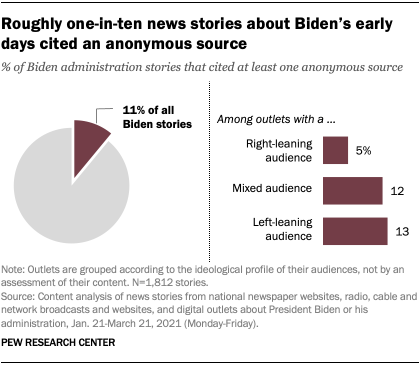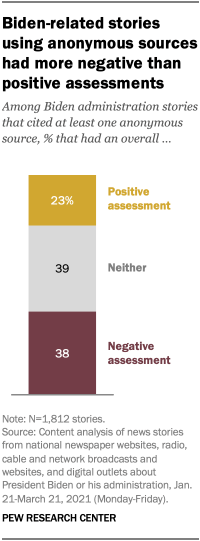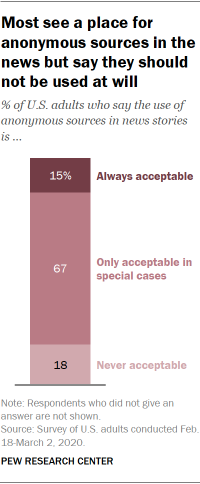Roughly one-in-ten news stories about Joe Biden’s early days as president cited an anonymous or unnamed source, according to a Pew Research Center analysis of media coverage of the administration’s first 60 days. And fewer than 1% of the stories relied solely on anonymous sources.
Overall, 11% of news stories about Biden’s administration during his first two months in office relied on at least one anonymous source, according to the analysis, which examined stories produced by 25 major national newspaper websites, radio, cable and network broadcasts and websites, and digital outlets from Jan. 21 to March 21, 2021. The findings are part of a broader Pew Research Center content analysis of early Biden coverage and come amid debates in the news industry over the use of anonymous sources.
News outlets with right-leaning audiences were less likely than other outlets to incorporate anonymous sources into their coverage. Just 5% of their stories used such sources, compared with 12% of stories in outlets with mixed audiences and 13% in outlets with left-leaning audiences. (Read more here about the news outlets included in this analysis and how we classified the ideological composition of their audiences.)
This analysis of anonymous source usage in news coverage of the early days of Joe Biden’s presidency builds on an April 2021 Pew Research Center report that examined the media’s broader coverage of the new administration, as well as Americans’ perceptions of that coverage.
The analysis of media content in this study is based on a selection of weekday media coverage collected from Jan. 21 to March 21, 2021. Stories were collected from television, radio, digital and print outlets and coded by a team of nine coders trained specifically for this project.
Part of this analysis examines the presence of anonymous sources cited in each news story evaluated. Citations included direct or indirect quotes, interviews, attributions or references accompanying factual information. Within each story, a source type was coded only once, even if it was cited repeatedly. For more information about the content analysis, see the methodology.
To examine Americans’ attitudes of anonymous sources, we surveyed 10,300 U.S. adults from Feb. 18 to March 2, 2020. Everyone who completed the survey is a member of the Center’s American Trends Panel (ATP), an online survey panel that is recruited through national, random sampling of residential addresses. Recruiting our panelists by phone or mail ensures that nearly all U.S. adults have a chance of selection. This gives us confidence that any sample can represent the whole population (see our Methods 101 explainer on random sampling). To further ensure that each survey reflects a balanced cross section of the nation, the data is weighted to match the U.S. adult population by gender, race, ethnicity, partisan affiliation, education and other categories. Read more about the ATP’s methodology.
Here are the questions used for this report, along with responses, and its methodology.
This is the latest post in Pew Research Center’s ongoing investigation of the state of news, information and journalism in the digital age, a research program funded by The Pew Charitable Trusts, with generous support from the John S. and James L. Knight Foundation.
One concern about anonymous sources is that allowing someone to speak under the cloak of anonymity makes it more likely that a source may say something negative.
When it comes to assessments of the Biden administration, news stories that cited anonymous sources were modestly more negative than the broader sample of stories studied by the Center.
Among those stories with anonymous sources, 38% carried a negative assessment, while 23% carried a positive assessment and 39% had neither. By comparison, among all the Biden stories studied in the administration’s early days, 32% had a negative assessment, 23% carried a positive one and 45% had neither. (In this study, researchers analyzed the statements in a story to determine how the article assessed the words or actions of Biden and his administration. Stories were coded as positive if they had at least twice as many positive as negative statements; they were coded as negative if the reverse was true. If neither threshold was met, the stories were considered neither positive nor negative. You can read the full methodology here.)
Stories with anonymous sources during the Biden administration’s first two months in office were most likely to be about the economy and immigration: 21% of stories that relied on at least one anonymous source were about each topic. The share was lower for stories focused on presidential appointments (15%), health care (8%) and the administration’s political skills (5%).
Public cautious on use of anonymous sources
In an early 2020 Pew Research Center survey, most Americans said they see some value in the use of anonymous sources, but only to a limited degree. Roughly two-in-ten U.S. adults (18%) said the use of such sources is never acceptable, and 15% said it is always acceptable, while the majority (67%) said anonymous sources are appropriate in “special cases.”
In that survey, 68% of Americans said anonymous sources in a story had a great deal of (21%) or some (47%) influence on how they evaluated a story’s credibility.
Many journalists argue that the use of anonymous sources can at times be essential and necessary, particularly in investigative journalism. But many within the industry share the public’s concern over when the use of such sources is justified, and many media organizations have established standards and rules on that subject.
Note: Here are the questions used for this report, along with responses, and its methodology.





